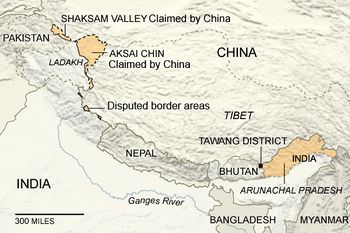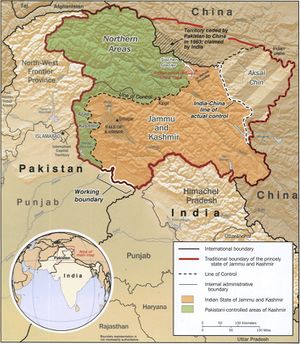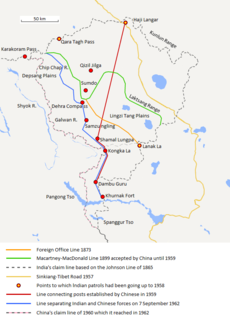آقصاي چن
Aksai Chin | |
|---|---|
Disputed territory | |
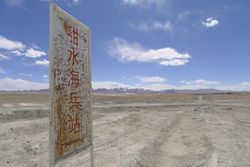 Tianshuihai army service station in Aksai Chin | |
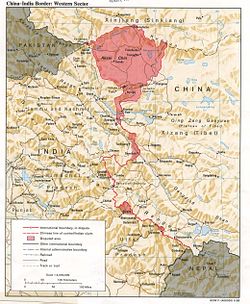 | |
| الإحداثيات: 35°7′N 79°8′E / 35.117°N 79.133°E | |
| البلد المسيطر | الصين |
آقصاي چن (إنگليزية: Aksai Chin؛ الصينية: 阿克赛钦; پنين: Ākèsàiqīn; هندي: अक्साई चिन, Aksā'ī cina؛ أردو: اکسائی چن ؛ وبالفارسية: اقصای چین) هي أحد منطقتي النزاع الرئيسيتين بين الصين والهند، والأخرى هي أروناچل پرادش. وتديرها الصين كجزء من ناحية هوتان في محافظة هوتان في منطقة شينجيانگ الذاتية الحكم الاويغورية، ولكنها أيضاً تطالب بها الهند كجزء من مقاطعة لداخ في ولاية جامو وكشمير. وفي 1962 تقاتلت الصين والهند في حرب قصيرة على آقصاي چن وأروناچل پرادش، ولكن في 1993 و 1996 وقع البلدان اتفاقيات لاحترام خط السيطرة الفعلي.[1]
الاسم
تفسر بعض المصادر الاسم آقصاي على أنه كلمة ذات أصل توركي تعني "صحراء الصخور البيضاء"، بما في ذلك عدد من المصادر الاستعمارية البريطانية،[2][3] والغربية المعاصرة،[4][5][6][7] والصينية،[8][9] والهندية.[10][11] بعض المصادر الحديثة تفسرها بدلاً من ذلك بأنها تعني "الغدير الأبيض".[12][13] وثمة مصدر واحد على الأقل يفسر آقصاي بأنها تعني "شرقي" بلهجة أويغور يرقند.[14]
أما معنى كلمة "چن" فهو موضع جدل.[13] ويُعتقد أنها تعني "الصين" من قِبل بعض المصادر الصينية،[8][9][15] والغربية،[2][6] والهندية.[14] وثمة مصدر واحد، على الأقل، يرى أنها تعني "ممر".[12] المصادر الأخرى تلغي "چن" في تفسيراتها.[3][4][5][7][10][11]
التاريخ
Because of its 5،000 متر (16،000 ft) elevation, the desolation of Aksai Chin meant that it had no human importance other than as an ancient trade route, which provided a temporary pass during summer for caravans of yaks between Xinjiang and Tibet.[16] For military campaigns, the region held great importance, as it was on the only route from Tarim Basin to Tibet that was passable all year round. The Dzungar Khanate used this route to enter Tibet in 1717.[17]
One of the earliest treaties regarding the boundaries in the western sector was signed in 1842. Ladakh was conquered a few years earlier by the armies of Raja Gulab Singh (Dogra) under the suzerainty of the Sikh Empire. Following an unsuccessful campaign into Tibet in 1840, Gulab Singh and the Tibetans signed a treaty, agreeing to stick to the "old, established frontiers", which were left unspecified.[18][19] The British defeat of the Sikhs in 1846 resulted in the transfer of the Jammu and Kashmir region including Ladakh to the British, who then installed Gulab Singh as the Maharaja under their suzerainty. British commissioners contacted Chinese officials to negotiate the border, who did not show any interest.[20] The British boundary commissioners fixed the southern end of the boundary at Pangong Lake, but regarded the area north of it as terra incognita.[21]
خط جونسون

William Johnson, a civil servant with the Survey of India proposed the "Johnson Line" in 1865, which put Aksai Chin in Kashmir.[22] This was the time of the Dungan revolt, when China did not control most of Xinjiang, so this line was never presented to the Chinese.[22] Johnson presented this line to the Maharaja of Kashmir, who then claimed the 18,000 square kilometres contained within,[22] and by some accounts territory further north as far as the Sanju Pass in the Kun Lun Mountains. The Maharajah of Kashmir constructed a fort at Shahidulla (modern-day Xaidulla), and had troops stationed there for some years to protect caravans.[23] Eventually, most sources placed Shahidulla and the upper Karakash River firmly within the territory of Xinjiang (see accompanying map).[بحاجة لمصدر] According to Francis Younghusband, who explored the region in the late 1880s, there was only an abandoned fort and not one inhabited house at Shahidulla when he was there – it was just a convenient staging post and a convenient headquarters for the nomadic Kirghiz.[24][بحاجة لمصدر غير رئيسي] The abandoned fort had apparently been built a few years earlier by the Kashmiris.[25][بحاجة لمصدر غير رئيسي] In 1878 the Chinese had reconquered Xinjiang, and by 1890 they already had Shahidulla before the issue was decided.[22] By 1892, China had erected boundary markers at Karakoram Pass.[26]
In 1897 a British military officer, Sir John Ardagh, proposed a boundary line along the crest of the Kun Lun Mountains north of the Yarkand River.[23] At the time Britain was concerned at the danger of Russian expansion as China weakened, and Ardagh argued that his line was more defensible. The Ardagh line was effectively a modification of the Johnson line, and became known as the "Johnson-Ardagh Line".
خط مكارتني-مكدونالد
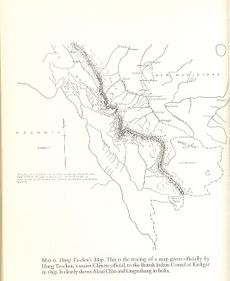
In 1893, Hung Ta-chen, a senior Chinese official at St. Petersburg, gave maps of the region to George Macartney, the British consul general at Kashgar, which coincided in broad details.[27]:pp. 73, 78 In 1899, Britain proposed a revised boundary, initially suggested by Macartney and developed by the Governor General of India Lord Elgin. This boundary placed the Lingzi Tang plains, which are south of the Laktsang range, in India, and Aksai Chin proper, which is north of the Laktsang range, in China. This border, along the Karakoram Mountains, was proposed and supported by British officials for a number of reasons. The Karakoram Mountains formed a natural boundary, which would set the British borders up to the Indus River watershed while leaving the Tarim River watershed in Chinese control, and Chinese control of this tract would present a further obstacle to Russian advance in Central Asia.[28] The British presented this line, known as the Macartney–MacDonald Line, to the Chinese in 1899 in a note by Sir Claude MacDonald. The Qing government did not respond to the note.[29] According to some commentators, China believed that this had been the accepted boundary.[30][31]
1899 إلى 1947
Both the Johnson-Ardagh and the Macartney-MacDonald lines were used on British maps of India.[22] Until at least 1908, the British took the Macdonald line to be the boundary,[32] but in 1911, the Xinhai Revolution resulted in the collapse of central power in China, and by the end of World War I, the British officially used the Johnson Line. However they took no steps to establish outposts or assert actual control on the ground.[26] In 1927, the line was adjusted again as the government of British India abandoned the Johnson line in favor of a line along the Karakoram range further south.[26] However, the maps were not updated and still showed the Johnson Line.[26]
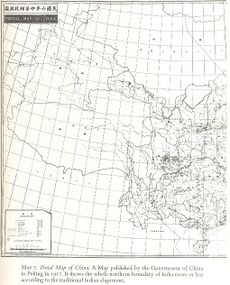
From 1917 to 1933, the Postal Atlas of China, published by the Government of China in Peking had shown the boundary in Aksai Chin as per the Johnson line, which runs along the Kunlun mountains.[27][31] The Peking University Atlas, published in 1925, also put the Aksai Chin in India.[33] When British officials learned of Soviet officials surveying the Aksai Chin for Sheng Shicai, warlord of Xinjiang in 1940–1941, they again advocated the Johnson Line.[22] At this point the British had still made no attempts to establish outposts or control over the Aksai Chin, nor was the issue ever discussed with the governments of China or Tibet, and the boundary remained undemarcated at India's independence.[26]
منذ 1947

Upon independence in 1947, the government of India used the Johnson Line as the basis for its official boundary in the west, which included the Aksai Chin.[26] From the Karakoram Pass (which is not under dispute), the Indian claim line extends northeast of the Karakoram Mountains through the salt flats of the Aksai Chin, to set a boundary at the Kunlun Mountains, and incorporating part of the Karakash River and Yarkand River watersheds. From there, it runs east along the Kunlun Mountains, before turning southwest through the Aksai Chin salt flats, through the Karakoram Mountains, and then to Panggong Lake.[16]
On 1 July 1954 Prime Minister Jawaharlal Nehru wrote a memo directing that the maps of India be revised to show definite boundaries on all frontiers. Up to this point, the boundary in the Aksai Chin sector, based on the Johnson Line, had been described as "undemarcated."[28]
During the 1950s, the People's Republic of China built a 1,200 km (750 mi) road connecting Xinjiang and western Tibet, of which 179 km (112 mi) ran south of the Johnson Line through the Aksai Chin region claimed by India.[16][26] Aksai Chin was easily accessible to the Chinese, but was more difficult for the Indians on the other side of the Karakorams to reach.[16] The Indians did not learn of the existence of the road until 1957, which was confirmed when the road was shown in Chinese maps published in 1958.[34]
The Indian position, as stated by Prime Minister Nehru, was that the Aksai Chin was "part of the Ladakh region of India for centuries" and that this northern border was a "firm and definite one which was not open to discussion with anybody".[16]
The Chinese minister Zhou Enlai argued that the western border had never been delimited, that the Macartney-MacDonald Line, which left the Aksai Chin within Chinese borders was the only line ever proposed to a Chinese government, and that the Aksai Chin was already under Chinese jurisdiction, and that negotiations should take into account the status quo.[16]
Despite this region being nearly uninhabitable and having no resources, it remains strategically important for China as it connects Tibet and Xinjiang. Construction started in 1951 and the road was completed in 1957. The construction of this highway was one of the triggers for the Sino-Indian War of 1962.[35] The resurfacing of the highway taken up for first time in about 50 years was completed in 2013.[36]
In June 2006, satellite imagery on the Google Earth service revealed a 1:500[37] scale terrain model[38] of eastern Aksai Chin and adjacent Tibet, built near the town of Huangyangtan, about 35 كيلومتر (22 mi) southwest of Yinchuan, the capital of the autonomous region of Ningxia in China.[39] A visual side-by-side comparison shows a very detailed duplication of Aksai Chin in the camp.[40] The 900 m × 700 m (3،000 ft × 2،300 ft)[بحاجة لمصدر] model was surrounded by a substantial facility, with rows of red-roofed buildings, scores of olive-colored trucks and a large compound with elevated lookout posts and a large communications tower. Such terrain models are known to be used in military training and simulation, although usually on a much smaller scale.
Local authorities in Ningxia claim that their model of Aksai Chin is part of a tank training ground, built in 1998 or 1999.[37]
In August 2017, Indian and Chinese forces near Pangong Tso threw rocks at each other.[41][42][43]
On September 11, 2019, People's Liberation Army troops confronted Indian troops on the northern bank of Pangong Lake.[44][45]
A continued face-off in May and June 2020 between Indian and Chinese troops near Pangong Tso Lake culminated in a violent clash on 16 June 2020, with at least 20 deaths from the Indian side and no official reported deaths from the Chinese side. Both sides claim provocation from the other. [46][47][42][48][49][50][51]
أرض ما وراء قرةقورم
الأهمية الاستراتيجية
الطريق الوطني الصيني 219 يجري عبر آقصاي چن رابطاً Lazi و شينجيانگ في منطقة التبت الذاتية. وعلى الرغم من أن تلك المنطقة تكاد تكون غير قابلة للسكنى تنعدم فيها الموارد، إلا أنها تبقى مهمة استراتيجياً للصين إذ أنها تربط التبت بشينجيانگ. بدأ الإنشاء في 1951 واكتمل الطريق في 1957. إنشاء هذا الطريق السريع كان أحد شرارات الحرب الصينية الهندية في 1962.
انظر أيضاً
الهامش
- ^ "India-China Border Dispute". GlobalSecurity.org.
- ^ أ ب Report on the Trade and Resources of the Countries on the North-western Boundary of British India. Printed at the Government Press. 1862. pp. xxii. c.
the "Aksai Chin," or as the term implies the great Chinese white desert or plain.
- ^ أ ب Journal of the Asiatic Society of Bengal. Bishop's College Press. 1868. p. 50.
the Akzai Chin or White Desert
- ^ أ ب Kaminsky, Arnold P.; Long, Roger D. (23 September 2011). India Today: An Encyclopedia of Life in the Republic [2 volumes]: An Encyclopedia of Life in the Republic. ABC-CLIO. p. 23. ISBN 978-0-313-37463-0. Archived from the original on 5 April 2020. Retrieved 11 January 2020.
Aksai Chin (as Uyghur name meaning "desert of white stones")
- ^ أ ب Sven Anders Hedin; Nils Peter Ambolt (1967). Central Asia Atlas, Memoir on Maps: Index of geographical names, by D.M. Farquhar, G. Jarring and E. Norin. Sven Hedin Foundation, Statens etnografiska museum. p. 12.
Aksai Chin, region between the K'unlun main range and the Loqzung Mountains: T. eq say 'white gravelly plain' + cin '(of) China' (Cin, earliest designation by which China was known in Central Asia).
- ^ أ ب Bertil Lintner (25 January 2018). China's India War: Collision Course on the Roof of the World. OUP India. p. 85. ISBN 978-0-19-909163-8.
The name Aksai Chin means 'the desert of white stones'
- ^ أ ب 夏征农; 陈至立, eds. (September 2009). 辞海:第六版彩图本 [Cihai (Sixth Edition in Color)] (in الصينية). 上海. Shanghai: 上海辞书出版社. Shanghai Lexicographical Publishing House. p. 0008. ISBN 9787532628599.
阿克赛钦 地名区。维吾尔语意即"中国的白石滩"。在新疆维吾尔自治区和田县南部、喀喇昆仑山和昆仑山间。
- ^ أ ب Zhou Enlai (Chou En-Lai) (15 November 1962). "Archived copy" 国务院总理周恩来就中印边界問題致亚非国家領导人的信 (PDF). 中华人民共和国国务院公报 (Bulletin of the State Council of PRC) (in الصينية): 228. Archived (PDF) from the original on 13 June 2015. Retrieved 30 December 2019 – via 中华人民共和国中央人民政府门户网站.
在西段,印度政府提出爭議的传统习惯綫以东和以北的地区,历来是屬于中国的。这个地区主要包括中国新疆所屬的阿克賽欽地区和西藏阿里地区的一部分,面积共为三万三千平方公里,相当于一个比利时或三个黎巴嫩。这个地区虽然人烟稀少,却历来是联結新疆和西藏阿里的交通命脉。新疆的柯尔克孜族和維吾尔族的牧民經常在这一带放牧。阿克賽欽这个地名就是維吾尔語"中国的白石滩"的意思。这块地方一直到現在是在中国的管轄之下。
{{cite journal}}: CS1 maint: archived copy as title (link) - ^ أ ب Gurdip Singh Kler (1995). Unsung Battles of 1962. Lancer Publishers. p. 156. ISBN 978-1-897829-09-7.
Aksai Chin - the name, means the desert of white stones.
- ^ أ ب Sanjeev Kumar Bhasin (2006). Amazing Land Ladakh: Places, People, and Culture. Indus Publishing. p. 61. ISBN 978-81-7387-186-3.
The Aksai Chin (desert of white stones)
- ^ أ ب Bob Butalia (30 September 2015). In the Shadow of Destiny. Partridge Publishing India. p. 271. ISBN 978-1-4828-5791-7.
'Aksai Chin' in translation means 'White Brook Pass'.
- ^ أ ب Geeta Kochhar (19 March 2018). China's Foreign Relations and Security Dimensions. Taylor & Francis. pp. 40–. ISBN 978-0-429-01748-3.
The etymology of Aksai Chin is uncertain. Although 'Aksai' is a Turk term for 'white brooks', it is widely believed that the word 'chin' has nothing to do with China.
- ^ أ ب Harish Kapadia (March 2002). High Himalaya Unknown Valleys. Indus Publishing. p. 309. ISBN 978-81-7387-117-7.
Aksai Chin, (Aksai: eastern, Chin: China) ... Most of the names were found to be distinctly Yarkandi.
- ^ خطأ استشهاد: وسم
<ref>غير صحيح؛ لا نص تم توفيره للمراجع المسماةrfa - ^ أ ب ت ث ج ح Maxwell, Neville (1970). India's China War. New York: Pantheon. p. 3. Archived from the original on 1 November 2013. Retrieved 4 January 2020.
At 17,000 feet elevation, the desolation of Aksai Chin had no human importance other than an ancient trade route that crossed over it, providing a brief pass during summer for caravans of yaks from Sinkiang to Tibet that carried silk, jade, hemp, salt
- ^ Gaver, John W. (2011). Protracted Contest: Sino-Indian Rivalry in the Twentieth Century. University of Washington Press. p. 83. ISBN 978-0295801209. Retrieved 4 January 2020.
The westerly route via Aksai Chin was an old caravan route and in many ways the best. It was the only route that was open year-round, throughout both the winter and the monsoon season. The Dzungar army that had reached Lhasa in 1717 ... had followed this route.
- ^ Maxwell, India's China War 1970, p. 24.
- ^ The Sino-Indian Border Disputes, by Alfred P. Rubin, The International and Comparative Law Quarterly, Vol. 9, No. 1. (Jan. 1960), pp. 96–125, JSTOR 756256.
- ^ Maxwell, India's China War 1970, p. 25–26.
- ^ Maxwell, India's China War 1970, p. 26.
- ^ أ ب ت ث ج ح Mohan Guruswamy, Mohan, "The Great India-China Game" Archived 30 سبتمبر 2016 at the Wayback Machine, Rediff, 23 June 2003.
- ^ أ ب Woodman, Dorothy (1969). Himalayan Frontiers. Barrie & Rockcliff. pp. 101 and 360ff.
- ^ Younghusband, Francis E. (1896). The Heart of a Continent. John Murray, London. Facsimile reprint: (2005) Elbiron Classics, pp. 223–224.
- ^ Grenard, Fernand (1904). Tibet: The Country and its Inhabitants. Fernand Grenard. Translated by A. Teixeira de Mattos. Originally published by Hutchison and Co., London. 1904. Reprint: Cosmo Publications. Delhi. 1974, pp. 28–30.
- ^ أ ب ت ث ج ح خ Calvin, James Barnard (April 1984). "The China-India Border War". Marine Corps Command and Staff College. Archived from the original on 11 November 2011. Retrieved 2011-10-14.
- ^ أ ب ت Woodman, Dorothy (1969). Himalayan Frontiers. London: Barrie & Rockliff, The Cresset Press.
- ^ أ ب Noorani, A.G. (30 August – 12 September 2003), "Fact of History", Frontline (Madras: The Hindu group) 26 (18), http://frontlineonnet.com/fl2018/stories/20030912002104800.htm, retrieved on 24 August 2011
- ^ Woodman, Himalayan Frontiers (1970), pp. 102: "The proposed boundary seems never to have been considered in the same form again until Alastair Lamb revived it in 1964".
- ^ "India-China Border Dispute". GlobalSecurity.org. Archived from the original on 15 February 2015.
- ^ أ ب Verma, Virendra Sahai (2006). "Sino-Indian Border Dispute at Aksai Chin – A Middle Path For Resolution". Journal of Development Alternatives and Area Studies. 25 (3): 6–8. ISSN 1651-9728.
- ^ Woodman (1969), p.79
- ^ Fisher, Margaret W.; Rose, Leo E.; Huttenback, Robert A. (1963). Himalayan Battleground: Sino-Indian Rivalry in Ladakh. Praeger. p. 101 – via Questia.
- ^ China's Decision for War with India in 1962 by John W. Garver Archived 26 مارس 2009 at the Wayback Machine
- ^ Guo, Rongxing (2007). Territorial Disputes and Resource Management. Nova Science Publishers. p. 43. ISBN 978-1-60021-445-5. Retrieved 2019-06-10.
- ^ Ying, Li (24 September 2014). "A road from n the sky". Global Times. Archived from the original on 24 September 2015. Retrieved 19 September 2015.
- ^ أ ب "Chinese X-file not so mysterious after all". The Age. Melbourne. 2006-07-23. Archived from the original on 13 January 2009. Retrieved 2008-12-17.
- ^ "Archived copy". Archived from the original on 20 December 2013. Retrieved 8 November 2016.
{{cite web}}: CS1 maint: archived copy as title (link) - ^ "From sky, see how China builds model of Indian border 2400 km away". Archived from the original on 2 January 2011. Retrieved 8 July 2009.
- ^ Google Earth Community posting Archived 8 ديسمبر 2008 at the Wayback Machine, 10 April 2007
- ^ 中共與印度邊境衝突!150士兵互毆10多人掛彩. New Tang Dynasty Television (in الصينية التقليدية). 11 May 2020. Retrieved 16 May 2020.
- ^ أ ب 費風 (11 May 2020). 中印邊境再爆衝突 150士兵毆鬥釀12傷. Hong Kong Economic Times (in الصينية التقليدية). Retrieved 16 May 2020.
消息指,第一起事件發生於5月5日至6日,在中印邊境的班公錯湖(Pangong Tso )地區,當時解放軍的「侵略性巡邏」(aggressive patrolling)被印度軍方阻攔。「結果發生了混亂,雙方都有一些士兵受傷。」{...}2017年8月,兩國軍隊曾於拉達克地區班公湖附近爆發衝突,當時雙方擲石攻擊對方,雙方均有人受傷,最終兩軍在半小時後退回各自據點。
- ^ Sushant Singh (20 May 2020). "India-China conflict in Ladakh: The importance of the Pangong Tso lake". The Indian Express. Retrieved 21 May 2020.
- ^ "Indian, Chinese Troops Face-off in Ladakh Ahead of Modi-Xi Summit, Army Says Tension De-escalated". CNN-News18. 12 September 2019. Archived from the original on 7 November 2019. Retrieved 12 May 2020.
- ^ Chang Ya-Han 張雅涵, ed. (10 March 2020). "Archived copy" 中國在西藏地區軍演頻繁 牽動中印未來危機應對. Radio Taiwan International (in Chinese (Taiwan)). Archived from the original on 11 March 2020. Retrieved 16 May 2020.
{{cite web}}: CS1 maint: archived copy as title (link) - ^ https://timesofindia.indiatimes.com/india/india-china-border-tensions-live-updates-at-least-20-indian-soldiers-killed-in-violent-face-off-with-china/liveblog/76396873.cms
- ^ Dinakar Peri (10 May 2020). "Indian, Chinese troops face off in Eastern Ladakh, Sikkim". The Hindu. Archived from the original on 12 May 2020. Retrieved 13 May 2020.
- ^ "Chinese military bolsters troops in Aksai Chin region in Sino-India border: Report". The Economic Times. 19 May 2020. Archived from the original on 19 May 2020. Retrieved 19 May 2020.
On May 5, around 250 Indian and Chinese army personnel clashed in Pangong Tso lake area in Eastern Ladakh.
- ^ "Chinese, Indian troops engage in border conflicts". Taiwan News. 25 May 2020. Retrieved 26 May 2020.
- ^ Drake Long (22 May 2020). "India Voices Unusual Criticism of China's Conduct in South China Sea". Radio Free Asia. Retrieved 27 May 2020.
Chinese and Indian troops clashed on May 5 over road construction the Indian side was completing at Pangong Tso, a glacial lake bordering Ladakh and Tibet.
- ^ "Transcript of Media Briefing by Official Spokesperson (May 21, 2020)". Ministry of External Affairs. 21 May 2020. Retrieved 27 May 2020.
وصلات خارجية
- China and Kashmir, by Jabin T. Jacob, published in The Future of Kashmir, special issue of ACDIS Swords and Ploughshares, Program in Arms Control, Disarmament, and International Security, University of Illinois, winter 2007-8.
- Conflict in Kashmir: Selected Internet Resources by the Library, University of California, Berkeley, USA; University of California, Berkeley Library Bibliographies and Web-Bibliographies list
| مناطق النزاع في شرق، جنوب، وجنوب شرق آسيا | |||
|---|---|---|---|
| النوع | المنطقة | الادارة الحالية | المطالبات |
| أراضي: | أكساي تشين | ||
| جبل بائكدو | |||
| Heixiazi / بولشوي اوسورييسكي (الجزء الشرقي)2 | |||
| Indo-Bangladesh enclaves3 | |||
| محافظة كاتشين | |||
| كشمير3 | |||
| محافظة كايين | |||
| شبه الجزيرة الكورية والجزر القريبة منها3 | |||
| بر الصين الرئيسي | |||
| شمال بورنيو (صباح)2 | |||
| منغوليا الخارجية2 | |||
| جبال پامير3 | |||
| فطاني | |||
| دولة شان | |||
| القرى الستة وأربعين شرق النهر2 | |||
| جنوب التبت (الآن أرونچال پرادش في الهند) | |||
| Tannu Uriankhai (now Tuva Republic of Russia)2 | |||
| Trans-Karakoram Tract | |||
| دولة وا | |||
| جزر ومياه: | جزر دياو يو تاي/ جزر سنكاكو | ||
| Kinmen | |||
| Kori Creek2 | |||
| Liancourt Rocks | |||
| Macclesfield Bank | |||
| Matsu | |||
| Paracel Islands | |||
| Pedra Branca, Middle Rocks, and South Ledge | |||
| جزر پراتاس | |||
| Scarborough Shoal | |||
| Socotra Rock | |||
| جزر كوريل الجنوبية | |||
| جزر سپراتلي3 | |||
| تايوان وPenghu2 | |||
| الهوامش: | 1حكومة في المنفى/جماعة منفية. 2Inactive dispute. 3Divided among multiple claimants. | ||
- Pages using gadget WikiMiniAtlas
- Articles containing صينية-language text
- CS1 uses الصينية-language script (zh)
- CS1 الصينية-language sources (zh)
- Harv and Sfn no-target errors
- CS1 الصينية التقليدية-language sources (zh-hant)
- CS1 Chinese (Taiwan)-language sources (zh-tw)
- Short description is different from Wikidata
- Articles containing هندي-language text
- Coordinates on Wikidata
- Articles containing إنگليزية-language text
- Pages using Lang-xx templates
- Articles containing Chinese-language text
- Articles containing فارسية-language text
- Articles with hatnote templates targeting a nonexistent page
- مقالات ينقصها مصادر موثوقة
- مقالات ينقصها مصادر موثوقة from October 2019
- Articles with unsourced statements from October 2019
- All pages needing factual verification
- Wikipedia articles needing factual verification from October 2019
- Articles with unsourced statements from July 2009
- الهند المستقلة
- آقصاي چن
- تاريخ جامو وكشمير
- نزاعات حدودية في الصين
- كشمير
- جغرافيا شينجيانگ
- نزاعات حدودية في الهند
- العلاقات الصينية الهندية
- Hotan Prefecture
